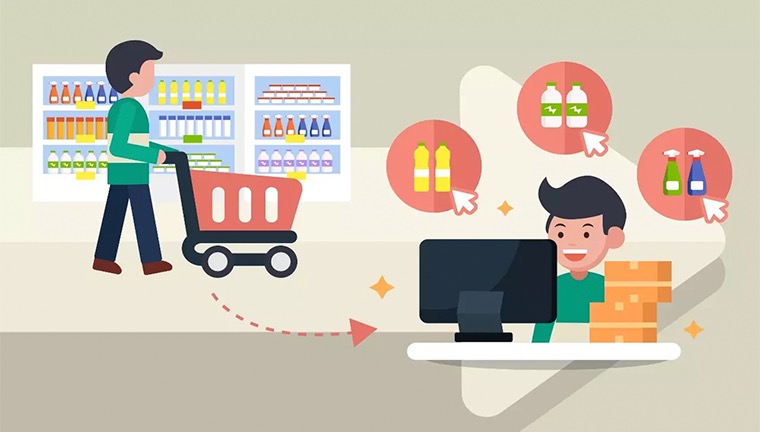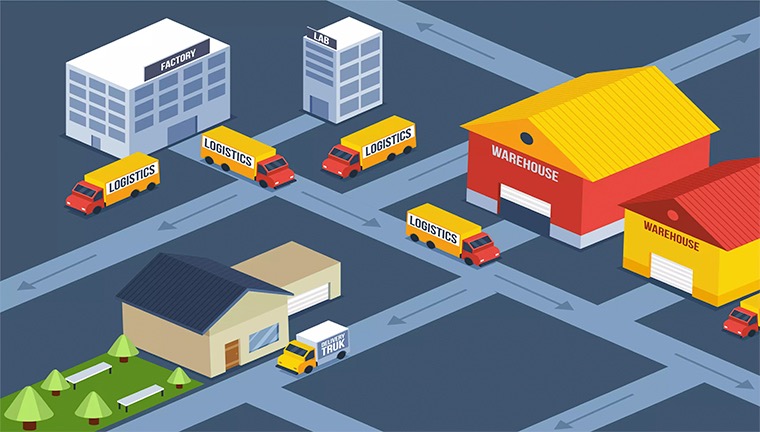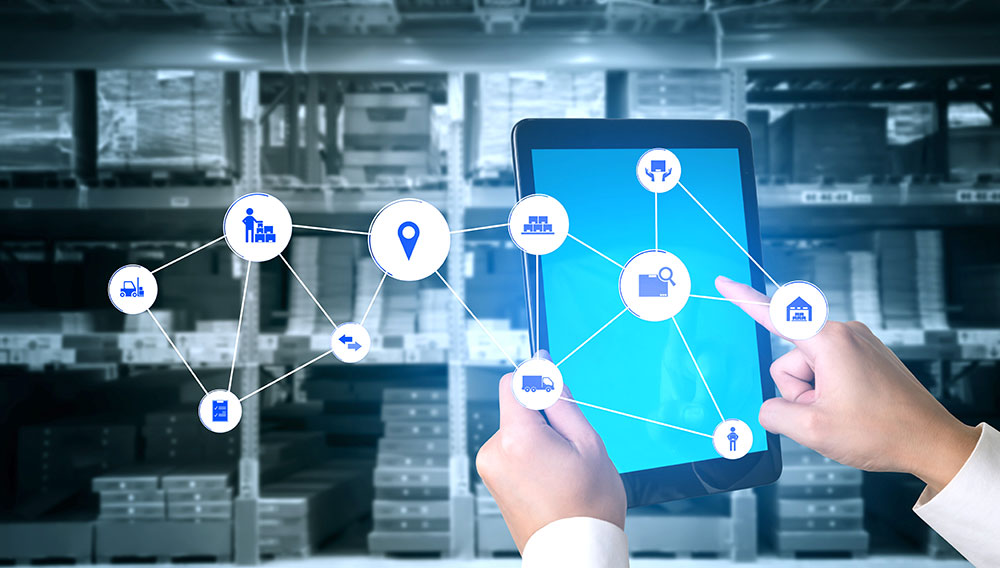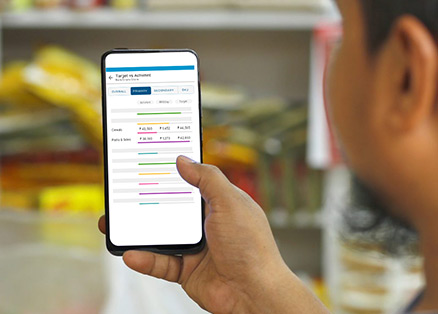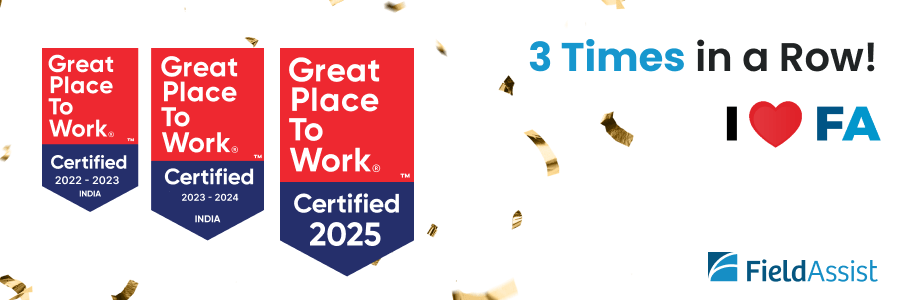What do we mean by Distribution Channels?
In the FMCG industry, a distribution channel is a route or approach that a company uses to get its products to reach the end consumers. There are multiple distribution channels available that the brand chooses to take depending on the type of consumers.
These days, distribution channels largely fall into 2 big buckets – Online and Offline.
- Online distribution: When CPG companies use their own website (D2C), ecommerce platforms and social media platforms to sell their products, those are online distribution channels, because the company doesn’t have to physically place their products in any brick & mortar shops. Orders received via these channels are fulfilled directly by the company’s or the eCommerce platform’s warehouses.
- Offline Distribution: The oldest way of making a product available to the consumers is being where they are. For centuries now, India has had a bustling traditional retail ecosystem where millions of shops dot the length and breadth of the country. From them to today, offline distribution channels have mushroomed.
Today there is unorganized retail or kirana trade or general trade, and then there is organized retail (modern trade or semi modern trade which includes minimarts, supermarkets, hypermarkets etc)
FMCG companies often utilize multiple distribution channels simultaneously to reach a wide range of consumers and cater to different market segments effectively. The specific distribution strategy depends on factors such as product type, target market, regional variations, and competitive landscape. For e.g. kirana stores are a great distribution channel for products that have mass appeal for e.g. a Rs 10 pack of biscuits or a 200 gms pouch of cooking oil etc.
However for niche products like organic staples, dry fruits or premium consumer packaged goods, channels like modern trade outlets, D2C are more productive.
But ensuring all distribution channels run like well-oiled machines can be quite a challenge for FMCG companies. Challenges such as operational inefficiencies, dismal channel performance, gaps in secondary sale insights, and negative impact on shareholder value are some of the reasons why most organizations look to connect the dots in the supply chain channels and optimize their distribution structure.
How do CPG brands optimize their distribution channels?
One of the most effective approaches to optimizing distribution effectiveness is by digitizing and automating the sales processes of frontline salespeople using technology tools.
Technology tools to streamline FMCG distribution
All across the globe, CPG organizations are adopting emerging technology tools to streamline distribution operations. We’ve listed the most popular ones for you:
Sales Force Automation
What was earlier exclusively a bastion for international companies has found favour with not just enterprise Indian brands but start-up FMCG companies as well who want to build data-powered GTM strategies. Research studies predict that Sales Force automation market will hit USD 18.65 Billion at a CAGR* of 10% by 2030.
Today more and more companies are now looking at enabling smart distribution channels, which require automation as well as smart analytics. By offering technology solutions in distribution and sales, Sales force automation tools like the FieldAssist GT App enable operational efficiencies for offline distribution channels. A typical SFA offers outlet validation, order booking, territory management, route optimization, schemes implementation, salesman performance visibility, real-time analytics etc.
https://www.fieldassist.com/blog/sfa-vs-crm/
Beauty Advisor/ Promoter App
FMCG companies employ merchandisers and promoters to offer their customers a closer experience with their products, especially for products like cosmetics, fresh dips and sauces, cold pressed juices, and other premium products. These promoters are usually placed at modern trade and semi-modern stores, but in some cases, the same promoter may be asked to manage 1 or more stores.
Promoter Apps like FieldAssist Modmart helps FMCG brands track tertiary sales, calculate stock opening and closing, assess planogram compliance, and manage share of shelf better via image recognition. Selfie-based attendance with geofencing also helps the brand ensure that its promoters are present in the store and are properly groomed. With the Store Evaluation Card, FMCG companies can get an exhaustive picture of their store’s performance, compare the performance of different regions/chains and track their top-performing SKUs.
Distributor Management System (DMS)
A distributor management system is an example of a powerful technology in channel management, which empowers FMCG companies with the capabilities to efficiently manage their distributor network.
With a DMS, brands get visibility on every distributor’s inventory; how many orders has he received from retailers, how many orders are fulfilled, how much inventory he still has, how many claims are under process and what’s the monthly realization etc. The Auto Replenishment System (ARS) feature ensures zero stockouts and intelligent inventory fulfilment.
For super stockists and distributors, a DMS is godsent which reduces their manual effort, digitizes and automates many daily tasks, and helps them become more profitable. With the FieldAssist DMS, all tax compliance protocols come pre-defined for generating correct Invoices. Distributors can easily manage returns by using the integrated e-invoicing and e-way option,
Van Sales
Conventionally, salespeople visit an outlet maybe once or twice a week to take orders from retailers. However, for some products like bread, eggs, milk etc, shelves need to be restocked every day. Therefore brands need to ensure that shops are visited almost daily. The same holds true for rural mom & pop stores who do not want to tie up their liquidity in weekly stock, rather they prefer buying daily stock based on the average daily consumer buying patterns.
For both these cases, the Van Sales app makes it easy for brands to manage orders, fulfilment and collection in the same visit. With load capacity visibility on each vehicle, sales managers can get a clear view of the total quantity and net value of stock and weight for calculating van capacity utilization. Depending on the place of delivery the FieldAssist Van Sales app offers pre-defined GST and taxes calculations for easy on-the-go billing. The app allows daily visibility on Van analytics with DSRs shared by the DSOs. Sales managers can compare van productivity vis-a-vis route productivity to improve the overall efficiency of Van operations.
Sales Analytics Apps
For the past few years, CPG companies have been vociferous proponents of Big data and, using it to take incisive decisions on supply chain optimization, new product development, demand forecasting, pricing, marketing campaigns etc.
Specialized analytics tools built for the CPG industry share critical business information about distribution networks, secondary sales, and customer buying behaviour. Take for example the FA Analytics app. Integrated with the FA App to track offline sales in kirana retail, it crunches the daily, weekly, and monthly numbers to give mid-managers a real-time assessment of individual level, outlet level and category level performance. This helps them identify red flags, identify root causes and also discover areas of opportunities that can scale up the business. The Quick Viz feature offers a visualized representation of complex numbers for managers to derive actionable insights and take quick decisions in the field.
Conclusion
The deployment of these key tools aims at enhancing operational efficiency levels, minimizing outage costs, and providing real-time intelligence to streamline sales processes and grow bottom-line revenues. Organizations immensely benefit from technology in distribution structure since it arrests gaps in the supply value chain channels and eliminates resource wastage. Thus, technology is key to establishing a robust supply chain and gaining long-term benefits.
Let’s identify those red flags for you and put your sales processes in turbo drive. Reach us today
*https://www.globenewswire.com/en/news-release/2022/10/04/2527818/0/en/Sales-Force-Automation-Market-Projected-to-Hit-USD-18-65-Billion-at-a-CAGR-of-10-by-2030-Report-by-Market-Research-Future-MRFR.html
Primary Keyword Used | Distribution channels |
Secondary Keywords used | technology in channel management smart distribution channels supply chain channels technology in distribution |
About Post Author
Nikhil Aggarwal
Driven by his passion for growth through automation, Nikhil takes pride in embarking his clients through a transformational journey and helps them be a more resilient, agile, and future-ready brand.




